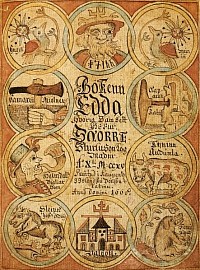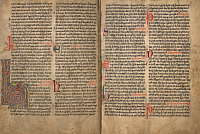Source material
The Poetic Edda
The Poetic Edda is a later manuscript dating from the second half of the 13th century, but containing older materials (hence its alternative title, the Elder Edda). It is a collection of mythological and heroic poems of unknown authorship, composed over a long period (AD 800–1100). They are usually dramatic dialogues in a terse, simple, archaic style that is in decided contrast to the artful poetry of the skalds.
The mythological cycle is introduced by Vǫluspá (“Sibyl’s Prophecy”), a sweeping cosmogonic myth that reviews in flashing scenes the history of the gods, men, and dwarfs, from the birth of the world to the death of the gods and the world’s destruction.
It is followed by Hávamál (“Sayings of the High One”), a group of disconnected, fragmentary, didactic poems that sum up the wisdom of the wizard-warrior god, Odin. The precepts are cynical and generally amoral, evidently dating from an age of lawlessness and treachery. The latter part contains the strange myth of how Odin acquired the magical power of the runes (alphabetical characters) by hanging himself from a tree and suffering hunger and thirst for nine nights. The poem ends with a list of magic charms.
One of the finest mythological poems is the humorous Thrymskvida (“Lay of Thrym”), which tells how the giant Thrym steals the hammer of the thunder god Thor and demands the goddess Freyja in marriage for its return. Thor himself journeys to Thrym, disguised as a bride, and the humour derives from the “bride’s” astonishing manners at the wedding feast, where she eats an ox and eight salmon, and drinks three vessels of mead.
The second half of the Poetic Edda contains lays about the Germanic heroes. Except for the Völundarkvida (“Lay of Völundr”; i.e., Wayland the Smith) these are connected with the hero Sigurd (Siegfried), recounting his youth, his marriage to Gudrun, his death, and the tragic fate of the Burgundians (Nibelungs). These lays are the oldest surviving poetic forms of the Germanic legend of deceit, slaughter, and revenge that forms the core of the great medieval German epic Nibelungenlied. Unlike the Nibelungenlied, which stands on the threshold of romance, the austere Eddic poems dwell on cruel and violent deeds with a grim stoicism that is unrelieved by any civilizing influences.
The Prose Edda
The Prose Edda, also known as the Younger Edda, Snorri's Edda (Icelandic: Snorra Edda) or, historically, simply as Edda, is an Old Norse textbook written in Iceland during the early 13th century. The work is often assumed to have been to some extent written, or at least compiled, by the Icelandic scholar, lawspeaker, and historian Snorri Sturluson c. 1220. It is considered the fullest and most detailed source for modern knowledge of Norse mythology, the body of myths of the North Germanic peoples, and draws from a wide variety of sources, including versions of poems that survive into today in a collection known as the Poetic Edda.
Title page of a late manuscript of the Prose Edda written by Snorri Sturluson (13th century), showing the Ancient Norse Gods Odin, Heimdallr, Sleipnir, and other figures from Norse mythology
The Prose Edda consists of four sections: The Prologue, a euhemerized account of the Norse gods; Gylfaginning, which provides a question and answer format that details aspects of Norse mythology (consisting of approximately 20,000 words), Skáldskaparmál, which continues this format before providing lists of kennings and heiti (approximately 50,000 words); and Háttatal, which discusses the composition of traditional skaldic poetry (approximately 20,000 words).
Dating from c. 1300 to 1600, seven manuscripts of the Prose Edda differ from one another in notable ways, which provides researchers with independent textual value for analysis. The Prose Edda appears to have functioned similarly to a contemporary textbook, with the goal of assisting Icelandic poets and readers in understanding the subtleties of alliterative verse, and to grasp the meaning behind the many kennings used in skaldic poetry.
Originally known to scholars simply as Edda, the Prose Edda gained its contemporary name in order to differentiate it from the Poetic Edda. Early scholars of the Prose Edda suspected that there once existed a collection of entire poems, a theory confirmed with the rediscovery of manuscripts of the Poetic Edda.[1]
Heimskringla
is the best known of the Old Norse kings' sagas. It was written in Old Norse in Iceland by the poet and historian Snorri Sturluson (1178/79–1241) c. 1230. The name Heimskringla was first used in the 17th century, derived from the first two words of one of the manuscripts (kringla heimsins, "the circle of the world").
Heimskringla is a collection of sagas about Swedish and Norwegian kings, beginning with the saga of the legendary Swedish dynasty of the Ynglings, followed by accounts of historical Norwegian rulers from Harald Fairhair of the 9th century up to the death of the pretender Eystein Meyla in 1177. The exact sources of the Snorri's work are disputed, but they include earlier kings' sagas, such as Morkinskinna, Fagrskinna and the 12th-century Norwegian synoptic histories and oral traditions, notably many skaldic poems. He explicitly names the now lost work Hryggjarstykki as his source for the events of the mid-12th century. Although Snorri used these and other materials collected during his trips to Norway and Sweden, he composed the sagas himself.
Gesta Danorum
Saxo Grammaticus, (flourished 12th century–early 13th century), historian whose Gesta Danorum (“Story of the Danes”) is the first important work on the history of Denmark and the first Danish contribution to world literature.
Little is known of Saxo’s life except that he was a Zealander belonging to a family of warriors and was probably a clerk in the service of Absalon, archbishop of Lund from 1178 to 1201. Saxo is first mentioned in Svend Aggesen’s Historia Regum Danicae compendiosa (1185; “Short History of the Danish Kings”) as writing the history of Svend Estridsen (d. 1076).
The Gesta Danorum was written at the suggestion of Archbishop Absalon: its 16 volumes begin with the legendary King Dan and end with the conquest of Pomerania by Canute IV in 1185. The work is written in a brilliant, ornate Latin. It was his Latin eloquence that early in the 14th century caused Saxo to be called “Grammaticus.” The first nine books of the Gesta Danorum give an account of about 60 legendary Danish kings. For this part Saxo depended on ancient lays, romantic sagas, and the accounts of Icelanders. His legend of Amleth is thought to be the source of William Shakespeare’s Hamlet; his Toke, the archer, the prototype of William Tell. Saxo incorporated also myths of national gods whom tradition claimed as Danish kings, as well as myths of foreign heroes. Three heroic poems are especially noteworthy, translated by Saxo into Latin hexameters. These oldest-known Danish poems are Bjarkemaalet, a battle hymn designed to arouse warlike feelings; Ingjaldskvadet, a poem stressing the corruptive danger of luxury upon the old Viking spirit; and Hagbard and Signe, a tragedy of love and family feuds. The last seven books contain Saxo’s account of the historical period, but he achieves independent authority only when writing of events close to his own time. His work is noteworthy for its sense of patriotic purpose based on a belief in the unifying influence of the monarchy. By presenting a 2,000-year-long panorama of Danish history, he aimed to show his country’s antiquity and traditions. Saxo’s work became a source of inspiration to many of the 19th-century Danish Romantic poets.
The Icelandic sagas
https://sagadb.org/index_az?fbclid=IwZXh0bgNhZW0CMTEAAR24TW4idU_zx2TpRuyIDrd84zaoq998CPCbhWC9FD-0hxC0gqFVg6IntfU_aem_RdtYd-dGfW1RU38Rrs_0sQ





